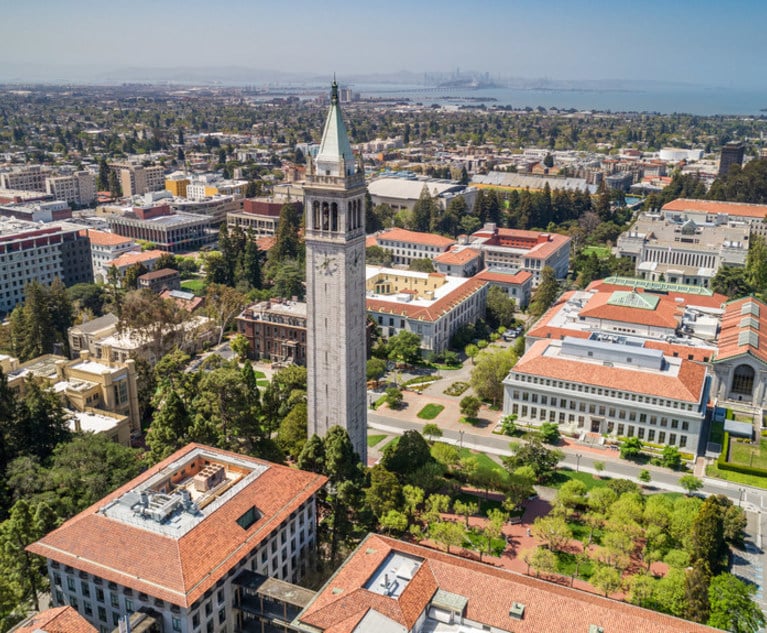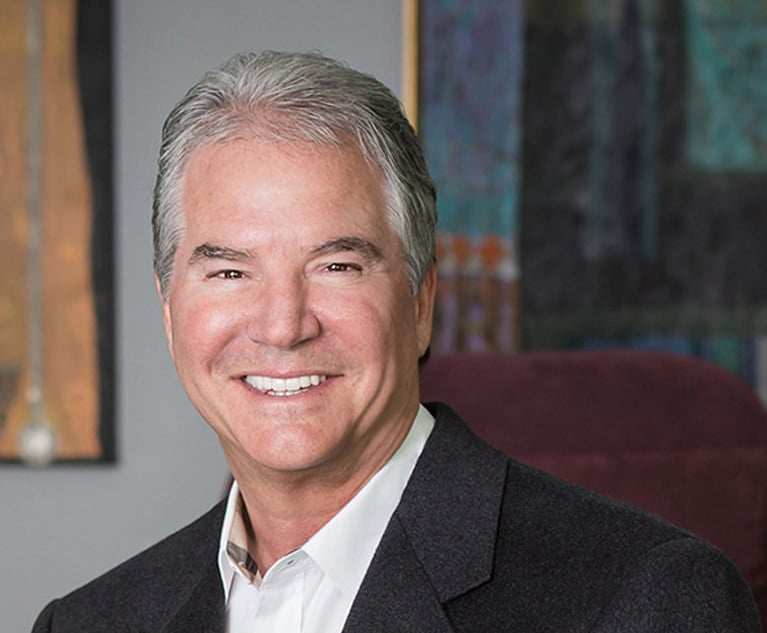Wilson Sonsini and BYU Join Forces to Help Asylum Seekers
With the help of Wilson Sonsini, BYU law students this spring will create a free tool for people applying for asylum. It's the third iteration of the school's LawX legal design lab program.
October 24, 2019 at 03:51 PM
4 minute read
 Photo: Jason Doiy.
Photo: Jason Doiy.
This spring, Silicon Valley powerhouse law firm Wilson Sonsini Goodrich & Rosati is teaming up with students at Brigham Young University J. Reuben Clark Law School to help design a program that will simplify the asylum application process.
It marks the first time that BYU's three-year-old LawX legal design lab is partnering with a law firm to create a new tool to address the access-to-justice problem. In addition to Wilson Sonsini, LawX is also working with SixFifty—the law firm's software subsidiary—to support the technical side of the asylum project.
"We have been impressed by LawX and SixFifty's work in tackling important legal issues through design thinking and its ability to bring pro bono solutions to people who do not otherwise have access to legal representation," said Wilson Sonsini managing partner Doug Clark.
Project leaders are hopeful that the resulting free asylum tool will prove as popular as earlier LawX-designed resources. In its first year, LawX students created an online tool to help assist people who have been sued over unpaid debt. It followed up last year with an app that helps improve communication between tenants and landlords, with the goal of reducing evictions. Usage of both programs, which are free, has since far exceeded expectations.
"[Wilson Sonsini] is the perfect firm for this," said LawX co-director Kimball Parker, who is also the president of SixFifty. "They really care about asylum. When they heard we were doing asylum, they wanted to be involved. There are asylum experts at the firm, which means we can tap into some of the smartest legal minds in the nation on asylum. Then we can lean on the engineers and designers of SixFifty, with it all driven by these law students."
The LawX legal design lab is among a growing number of programs at law schools that task students with harnessing technology to address legal problems. The courses require students to evaluate the legal issues at play and the barriers that clients face, and to conceive apps and tools that help close that justice gap—placing them in the dual role of attorney and engineer. Stanford Law School has an interdisciplinary Legal Design Lab and offers several courses for students. Suffolk University School of Law's Legal Innovation and Technology Lab functions as a consultancy and research and development lab centered on legal tech. And Georgetown University Law Center has since 2013 hosted the Iron Tech Lawyer Invitation, in which student teams from around the country present their technology solutions to legal problems, just to name a few.
In the LawX course, students begin by researching the legal topic at hand, which this spring is asylum. They will speak with immigration judges, advocates, attorneys who represent clients in asylum cases, as well as people seeking asylum, Parker said. Next, they will brainstorm how best to help asylum seekers before creating prototypes of technology solutions, then perfecting them. SixFifty helped create last year's landlord and tenant communication app, but never before have the BYU students had access a law firm to help them work through the legal issues.
"This is like no other class they've ever had," Parker said. "There is almost no syllabus. We know, generally, what steps we're going to go through, but I don't know what we're going to do each day."
Asylum was a natural topic for LawX to focus on, given that the law school already does work on the immigration front, said law dean Gordon Smith. Teams of law students and faculty travel to the country's largest detention center in Dilley, Texas, several times a year to interview women seeking asylum. Additionally, the school's Law Community Legal Clinic offers direct representation to clients in immigration matters, thought a partnership with Deseret Industries.
"There are hundreds and thousands of people in the U.S. who are here, and maybe have good cases for asylum, but they can't afford an attorney or don't know how to fill out the paperwork," Parker said. "I think we can make a really big difference for them."
This content has been archived. It is available through our partners, LexisNexis® and Bloomberg Law.
To view this content, please continue to their sites.
Not a Lexis Subscriber?
Subscribe Now
Not a Bloomberg Law Subscriber?
Subscribe Now
NOT FOR REPRINT
© 2025 ALM Global, LLC, All Rights Reserved. Request academic re-use from www.copyright.com. All other uses, submit a request to [email protected]. For more information visit Asset & Logo Licensing.
You Might Like
View All
Lawsuit Accuses University of California of Racial Discrimination in Admissions
4 minute read
Assessing the Second Trump Presidency’s Impact on College Sports


LSAT Administrator Sues to Block AI Tutor From Using ‘Famous, Distinctive’ Test Prep Materials
3 minute readTrending Stories
- 1States Accuse Trump of Thwarting Court's Funding Restoration Order
- 2Microsoft Becomes Latest Tech Company to Face Claims of Stealing Marketing Commissions From Influencers
- 3Coral Gables Attorney Busted for Stalking Lawyer
- 4Trump's DOJ Delays Releasing Jan. 6 FBI Agents List Under Consent Order
- 5Securities Report Says That 2024 Settlements Passed a Total of $5.2B
Who Got The Work
J. Brugh Lower of Gibbons has entered an appearance for industrial equipment supplier Devco Corporation in a pending trademark infringement lawsuit. The suit, accusing the defendant of selling knock-off Graco products, was filed Dec. 18 in New Jersey District Court by Rivkin Radler on behalf of Graco Inc. and Graco Minnesota. The case, assigned to U.S. District Judge Zahid N. Quraishi, is 3:24-cv-11294, Graco Inc. et al v. Devco Corporation.
Who Got The Work
Rebecca Maller-Stein and Kent A. Yalowitz of Arnold & Porter Kaye Scholer have entered their appearances for Hanaco Venture Capital and its executives, Lior Prosor and David Frankel, in a pending securities lawsuit. The action, filed on Dec. 24 in New York Southern District Court by Zell, Aron & Co. on behalf of Goldeneye Advisors, accuses the defendants of negligently and fraudulently managing the plaintiff's $1 million investment. The case, assigned to U.S. District Judge Vernon S. Broderick, is 1:24-cv-09918, Goldeneye Advisors, LLC v. Hanaco Venture Capital, Ltd. et al.
Who Got The Work
Attorneys from A&O Shearman has stepped in as defense counsel for Toronto-Dominion Bank and other defendants in a pending securities class action. The suit, filed Dec. 11 in New York Southern District Court by Bleichmar Fonti & Auld, accuses the defendants of concealing the bank's 'pervasive' deficiencies in regards to its compliance with the Bank Secrecy Act and the quality of its anti-money laundering controls. The case, assigned to U.S. District Judge Arun Subramanian, is 1:24-cv-09445, Gonzalez v. The Toronto-Dominion Bank et al.
Who Got The Work
Crown Castle International, a Pennsylvania company providing shared communications infrastructure, has turned to Luke D. Wolf of Gordon Rees Scully Mansukhani to fend off a pending breach-of-contract lawsuit. The court action, filed Nov. 25 in Michigan Eastern District Court by Hooper Hathaway PC on behalf of The Town Residences LLC, accuses Crown Castle of failing to transfer approximately $30,000 in utility payments from T-Mobile in breach of a roof-top lease and assignment agreement. The case, assigned to U.S. District Judge Susan K. Declercq, is 2:24-cv-13131, The Town Residences LLC v. T-Mobile US, Inc. et al.
Who Got The Work
Wilfred P. Coronato and Daniel M. Schwartz of McCarter & English have stepped in as defense counsel to Electrolux Home Products Inc. in a pending product liability lawsuit. The court action, filed Nov. 26 in New York Eastern District Court by Poulos Lopiccolo PC and Nagel Rice LLP on behalf of David Stern, alleges that the defendant's refrigerators’ drawers and shelving repeatedly break and fall apart within months after purchase. The case, assigned to U.S. District Judge Joan M. Azrack, is 2:24-cv-08204, Stern v. Electrolux Home Products, Inc.
Featured Firms
Law Offices of Gary Martin Hays & Associates, P.C.
(470) 294-1674
Law Offices of Mark E. Salomone
(857) 444-6468
Smith & Hassler
(713) 739-1250






